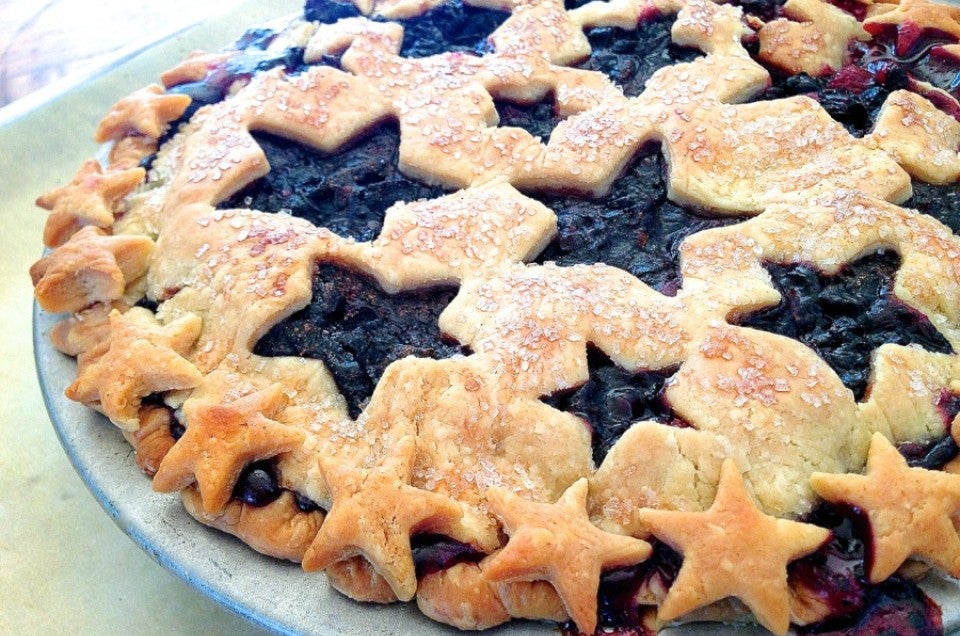


I don't know about you, but every time I look at a pie recipe and see one of those lattice-crust diagrams, I breathe a heavy sigh and turn the page. Or click to the next search result.
To those who love weaving lattice crusts: I salute you. You tell me it's not hard, once you get the hang of it. You tell me, "Just follow the pictures; take it one step at a time." You're right. I'm a reasonably intelligent person, and I should be able to follow a few simple diagrams.
And then I click to the next recipe anyway.
Hmmm, old dog who can't learn new tricks? Not at all. I'm at ease with everything from iPhoto to Instagram. I appreciate apps. I've even embraced online banking (though, despite my son's scoffing, I still "balance my checkbook.")
I can download and upload with the best of them.
What I have trouble with is offloading. As in, too much on my plate (and I don't mean the dessert plate). Thus if there's an easier/faster/just-as-effective way to do anything – I'm there.
So, what's the purpose of a lattice-top crust on a fruit pie, anyway?
1. It looks pretty.
2. It allows more steam to escape, more quickly, from the bubbling fruit filling below – so the filling is less likely to be runny.
Well then, how about if I make a top crust that's open enough to let steam escape; is handsome as a lattice, AND doesn't require either following a diagram, or a post-grad degree in hand-eye coordination?
I'm on it!
Let's cut right to the chase here. I've already made a Classic Double Pie Crust. Half of the pastry is in a 9" pie pan, filled with Bumbleberry Pie filling.
The other half, I roll between two 9" parchment rounds, the kind you use to line a cake pan.
Why the parchment rounds? Because they're a great guide for the 9" pastry round I'm shooting for; and they're non-stick. Oh, and also, there's no cleaning a floury counter afterwards.
Once the pastry is rolled, I trim the edges with a pair of scissors. Not strictly necessary; but it does make a nice round – no raggedy edges!
You can also roll on a parchment sheet, with a round on top – then trim with a pizza wheel. The advantage of this is, you can then use the parchment to line the baking sheet that'll hold your pie as it bakes. The parchment will catch those inevitable sticky spills from the bubbling filling.
Next, select your favorite cutters. Hearts, circles, stars (my personal favorite) – whatever floats your boat.
Cut out designs, and lay them on a baking sheet. Sprinkle them with cinnamon-sugar, and bake them right along with the pie. Baker's treat!
Heck, if you have a square cutter, you can even make a "faux lattice" by simply cutting out rows of squares.
Flop the crust, parchment-side up, onto the filled pie. Carefully peel off the parchment.
Press the top and bottom crusts together; make a simple crimp.
Sprinkle the crust with coarse white sparkling sugar, if desired. It's pretty and glittery, and adds sweet crunch to your finished pie.
In case you're wondering why that filling peeking through the crust looks rather brown and "sandy" – it is. I sprinkled the filling with a thick layer of cinnamon-sugar before adding the top crust – just because.
Want to go the extra mile? Press some of the cutouts around the edge of the crust. I made some of these small stars out of the larger stars and trimmings.
Bake the pie.
My, oh my...
A couple of hints:
Cold, firm pastry is much easier to work with than warm, soft/sticky pastry. As soon as your crust starts to stick – to the cutters, the parchment, or your fingers – give it a quick chill in the fridge.
Don't expect perfection. The filling bubbles as it bakes, and inevitably it'll spill up and over some of your pretty design. And that, friends, is why we use the word "rustic." It justifies a multitude of culinary mishaps.
Enjoy!







